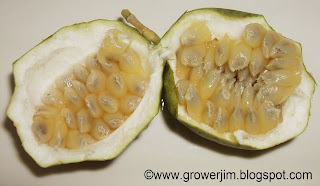Passiflora incarnata, or Maypop as it is commonly known, is a deciduous species of Passionflower native to the southeastern U.S. (USDA Zones 6-9). They will flourish in full sun to light shade.
The plants emerge in early spring and quickly start spreading over the surface of the ground. If the vines find something to climb on, up they go to a height of nearly 12 feet.
The vines are host to the larvae of Gulf Fritillary and Zebra Longwing butterflies, as well as the Banded Hairstreak, and Julia. The adult butterflies also visit the open flowers for nectar.
The blooms are similar to many species of Passiflora, and this is also one of the fruiting types. The flowers have an intoxicating fragrance. As soon as the blossoms fade, the young fruits start to develop.
The remnants of the flower remain even as the fruit approaches mature size.
The fruits will grow larger than a hen's egg to near tennis ball size, and when they are ripe, they turn a dull yellow-green color. When mature, the passionfruit will develop the characteristic fragrance, and the skin may become puckered or puffy.
At this stage, the passionfruit is ready to eat! Simply cut in half and spoon out the contents.
The edible fruit of Passiflora incarnata is not as slimy as some other species of passionfruit. In this species, the juice is firmly contained within the numerous juice sacs inside the fruit. They can be spooned out and eaten without breaking and spilling their contents. The fruit can also be pressed or processed for juice, and used to flavor ice creams and other delicious treats!
A tea made from the dried leaves is supposed to soothe nerves and cure insomnia.
Maypops spread by seed and root suckers, so once you have them established in your garden, you will always have a plentiful supply of butterflies and fruit!








12 comments:
Great post - I'm going to grow that. How does it do in pots?
I have the passiflora "incense" which is a hybrid of maypop and p. cincinnata, and though it smells amazing I never get any fruit. :(
Wow, it's so nice to be able to harvest your own passion fruits from your garden. I have always love the fragrance of passion fruits. It goes very well in tarts too.
Byddi: They will grow in pots but not multiply as much as if they were in the ground. Add a trellis or tomato cage in the pot so they have somewhere to climb.
I have two different kinds of passion vines, one I believe is incense, and the other is a smaller, less intensely colored variety. Neither has fruit that I can see and I've had these for years. Is there a reason for this?
I just found your blog through Meems at Hoe and Shovel. Very informative and great pictures.
FlowerLady
FlowerLady: There are many ornamental varieties of Passionflower that never set fruit. Even the fruiting varieties often benefit from cross-pollination of different genetic strains--one plant may be incapable of self-pollination but receptive to pollen from sibling seedlings. If you want fruit, the best bet is to buy a plant that is a known fruiting variety, or start seeds from a ripe passionfruit.
As well as the fruit being so delicious, Incarnata leaves, collected after fruiting and then dried, are mildly sedative, anti-spasmodic and anti-anxiety. Passionflower promotes relaxation. Nervous disorders such as anxiety and irritability benefit from the use of Passionflower, including digestive complaints of nervous origin. Passionflower is also valuable in the treatment of insomnia, tension headaches and muscle spasms in the body. And, it has proven to be very safe and non-addictive with no side effects!
Hi Jim,
Gosh, I have this variety of passion fruit, and I didn't know the leaves had such properties. I just love the flower-my all-time favourite. I used to have the red passiflora too, byt the plant got too invasive.Oh, amd we have pineapples in common too. The first (and only) fruit I harvested was heavenly! Hope the second one appears soon. I didn't know I could
propagate them from suckers as you had demonstrated. Great tip! My first plant took exactly 3 years to bear fruit! sigh
Good learning from you, Jim. Thanks,
Rosie
We live in the Tampa Bay area and my son brought some of the fruits home. They aren't ripe yet, but it was very interesting to learn what they are! We'll get him to show us where he found them and keep an eye on them for when they ripen.
How can I get a plant or seeds to grow in my garden?
Aida Canales,
I don't know where you're located, but if you live within the range where P. incarnata is native you can often find it growing along roadsides or at the edge of open meadows. Small plants transplant fairly well as long as you get a good root system. Seeds have variable germination. Some may come up quickly and others may take months before you see any signs of growth.
According to Van der Plank, who wrote a book on Passionflowers, P. "Incense" is edible, with a rose-like aroma, but is pollen sterile. It might bear fruit with a suitable partner (incarnata?). I had one that I planted on my folk's back 40, along with P. caerulea (edible but insipid) as a frost-hardy "daddy," but the Gulf Frits preferentially ate P. caerulea out of existence (Incense became a weed, then reached a sort of dynamic equilibrium with the caterpillars--the vine always spreading by rhizomes but kept thin and nonthreatening by the butterfly). So now only 1 clone and no fruit. Maybe 2 clones of maypop would help. Anyway Maypop flavor descriptions ("sour apricot") sound like something I could use more than rosewater.
Post a Comment